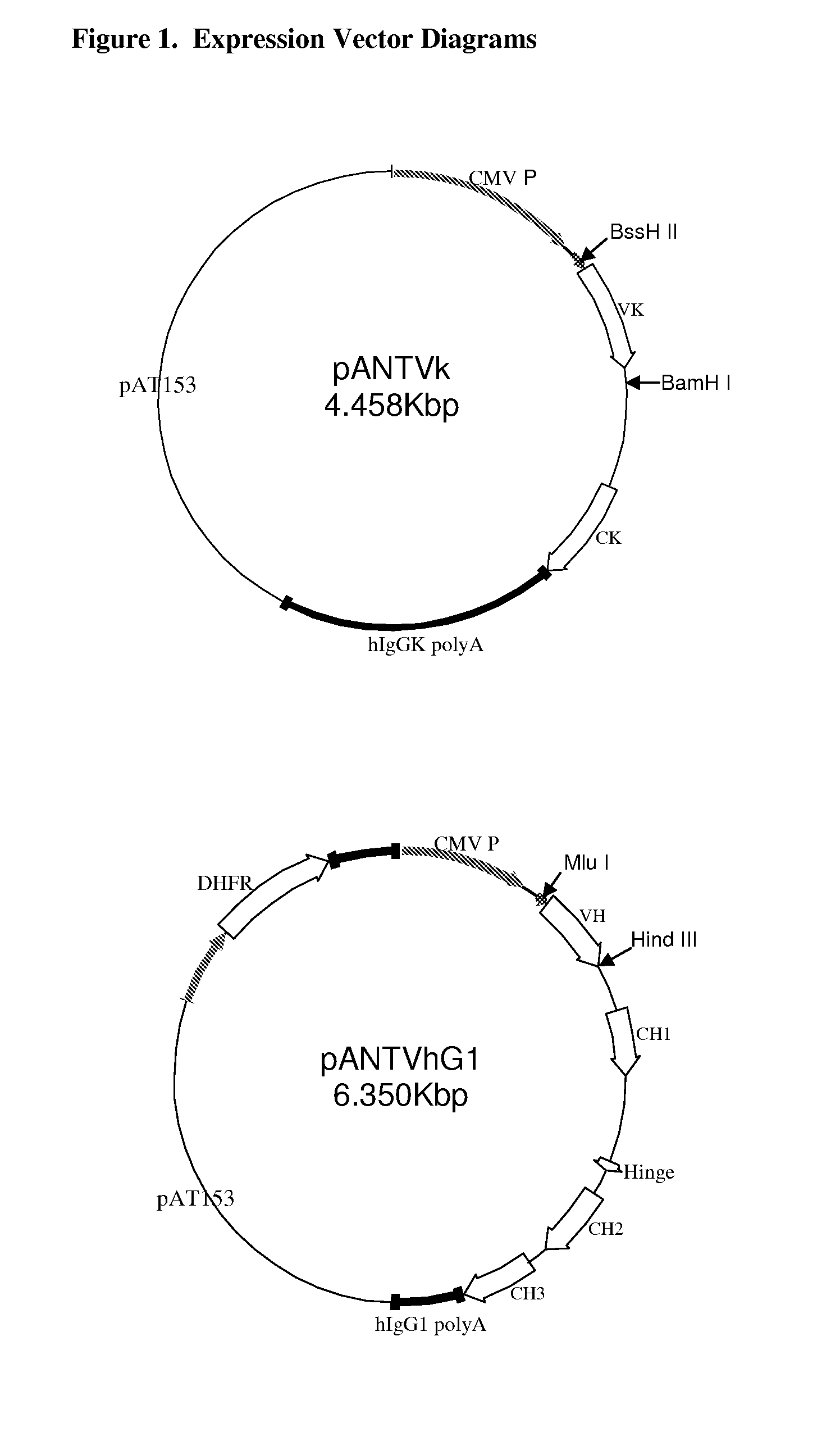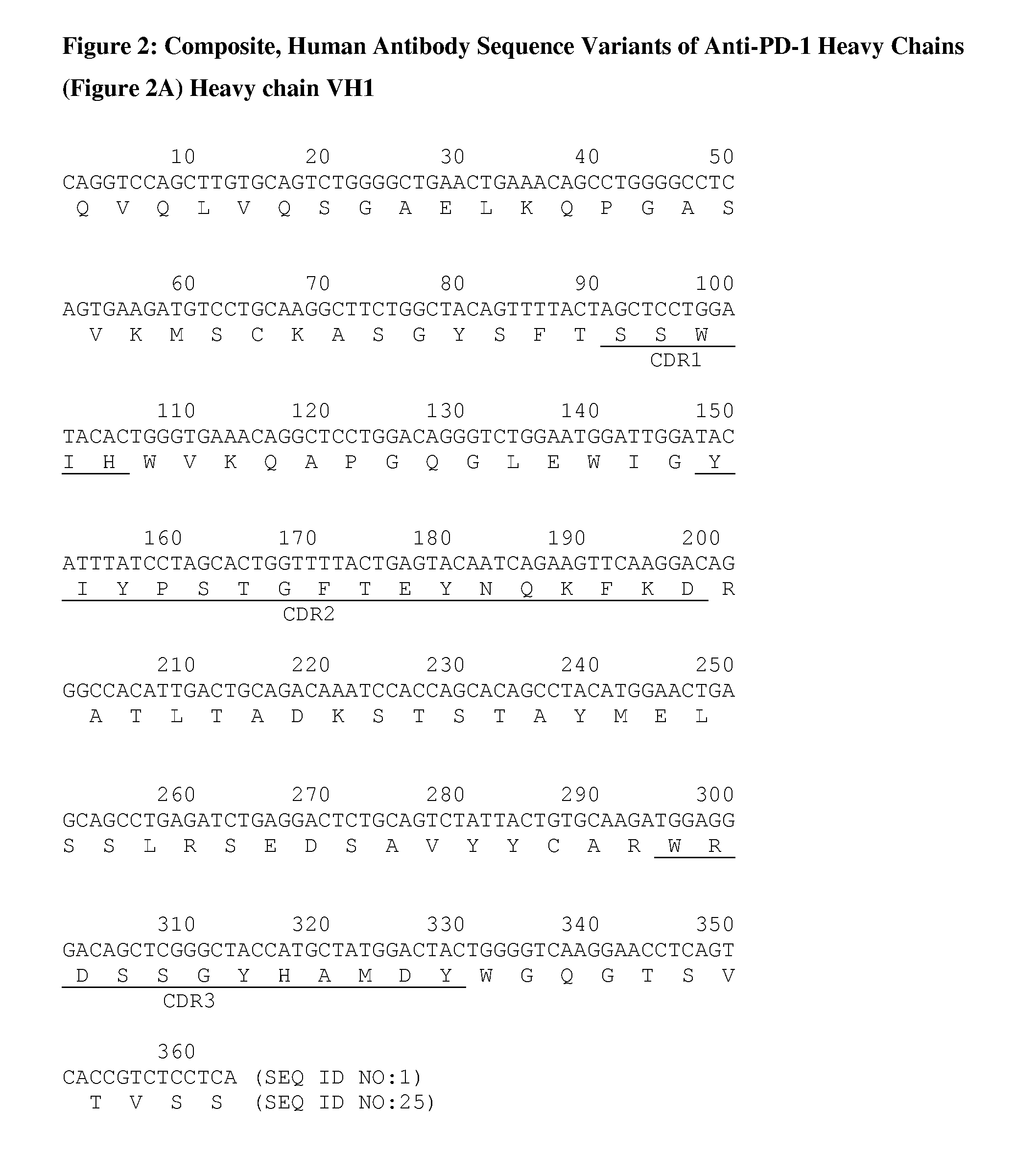Human Anti-pd-1, pd-l1, and pd-l2 antibodies and uses therefor
a technology of human antigens and antibodies, which is applied in the field of human antipd1, pdl1, and pdl2 antibodies, can solve the problems of high cytokine expression and cell expansion, and achieve the effects of reducing antigen binding affinities, retaining immunogenicity, and less immunogenicity
- Summary
- Abstract
- Description
- Claims
- Application Information
AI Technical Summary
Benefits of technology
Problems solved by technology
Method used
Image
Examples
example 1
Design of Composite, Human Antibody Variable Region Sequences
[0267]Structural models of the mouse EH12.2H7, 29E.2A3 and 24F.10C12 V regions were produced using Swiss Pdb and analyzed in order to identify important “constraining” amino acids in the mouse V regions that might be essential for the binding properties of the antibodies. Only residues contained within the CDRs were considered to be important, including CDR residues defined under both Kabat and Chothia definitions.
[0268]From the above analysis, it was considered that composite, human forms of EH12.2H7, 29E.2A3 and 24F.10C12 could be created with wide latitude of sequences outside of CDRs but with a narrow menu of possible alternative residues within the CDR sequences. Preliminary analysis indicated that corresponding sequence segments from several human antibodies could be combined to create CDRs similar or identical to those in the mouse sequences. For regions outside of and flanking the CDRs, a wide selection of human se...
example 2
Generation and Testing of Composite, Human Antibodies
[0271]Initial variant 1 composite, human antibody VH and VK region genes were synthesized for EH12.2H7, 29E.2A3 and 24F.10C12 using a series of overlapping oligonucleotides that were annealed, ligated and PCR amplified to give full length synthetic V-regions (FIG. 2A, FIG. 3A, FIG. 4A, FIG. 5A, FIG. 6A and FIG. 7A). For each composite, human antibody, subsequent sequence variants were constructed using long overlapping oligonucleotides and PCR, using the initial variant 1 as the template. The assembled variants were then cloned directly into expression vectors (FIG. 1) and their sequences were verified.
[0272]All combinations of chimeric and composite heavy and light chains (i.e. a total of 20 pairings for each antibody) were stably transfected into NS0 cells by electroporation and selected in media (high glucose DMEM with L-glutamine and Na pyruvate, 5% ultra-low IgG FCS, pen / strep—all from Invitrogen) containing 200 nM methotrexa...
example 5
Enhanced Stimulation of T Cell Activation by Inhibition of PD-1:PD-Ligand Interaction
[0278]The PD-1 signaling pathway inhibits moderate TCR / CD28 costimulatory signals, with cytokine production being reduced first without a decrease in T cell proliferation. As the TCR / CD28 costimulatory signals weaken, the PD-1 pathway dominates, with a great reduction in cytokine production accompanied by a reduction in proliferation. Accordingly, in order to confirm that the inhibition of the PD-1 pathway via inhibition of the interaction with PD-L1 or PD-L2 using composite, human antibodies of the invention enhances T cell activation, mixed lymphocyte reactions (MLRs) are performed.
[0279]Immature myeloid dendritic cells are isolated by culturing human peripheral blood monocytes in IL-4 and GM-CSF. Exposure of immature dendritic cells to an inflammatory cocktail of IL-1β, TNF-α, IL-6, and PGE2 elicits the development of mature dendritic cells that function as APCs. However, the addition of IL-10 to...
PUM
| Property | Measurement | Unit |
|---|---|---|
| concentration | aaaaa | aaaaa |
| concentration | aaaaa | aaaaa |
| concentration | aaaaa | aaaaa |
Abstract
Description
Claims
Application Information
 Login to View More
Login to View More - R&D
- Intellectual Property
- Life Sciences
- Materials
- Tech Scout
- Unparalleled Data Quality
- Higher Quality Content
- 60% Fewer Hallucinations
Browse by: Latest US Patents, China's latest patents, Technical Efficacy Thesaurus, Application Domain, Technology Topic, Popular Technical Reports.
© 2025 PatSnap. All rights reserved.Legal|Privacy policy|Modern Slavery Act Transparency Statement|Sitemap|About US| Contact US: help@patsnap.com



